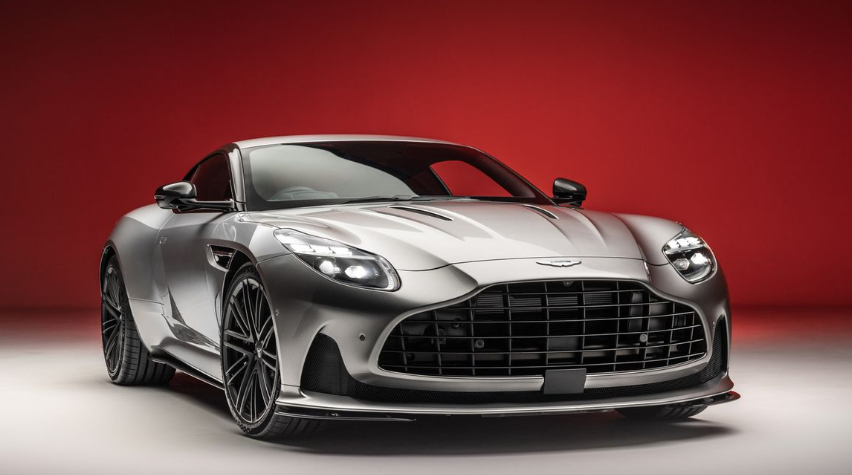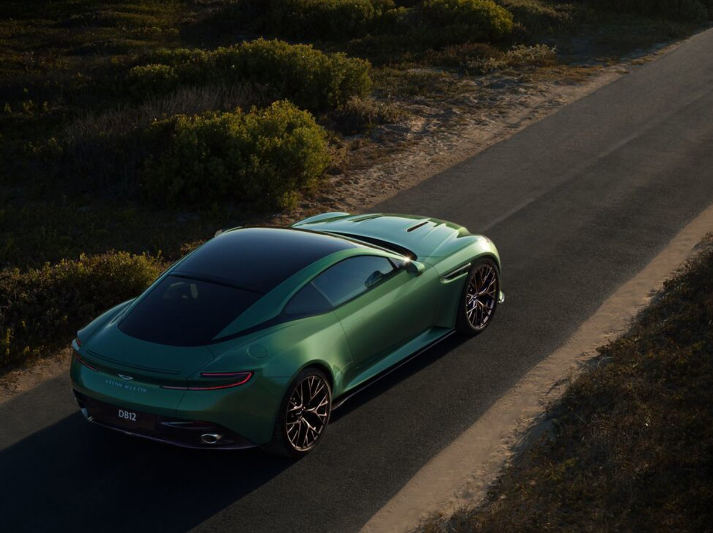Aston Martin is having a great year. Fernando Alonso is not only putting Aston Martin’s logo on the front row of the Formula 1 grid but also the company is celebrating its 110th birthday. The launch of a new Aston Martin DB is the perfect way to celebrate this milestone. Especially since the DB moniker itself is 75 years old. The 2024 Aston Martin DB12 is the first of eight Astons that will debut in the next 24 months.

Roberto Fedeli is Aston Martin’s chief technology officer. He calls the DB12 a “statement vehicle.” It’s hard to argue with the headline figures: 671 horsepower; 0-60 mph is 3.5 seconds; and a top speed of 202 mph. All this from a car that replaces Aston’s previous entry-level grand touring model, the DB11V-8. If we dig a bit deeper, then perhaps we can forgive the Aston HQ team for claiming that this is the first super-tourer in the world. Grand isn’t enough.”
2024 Aston Martin DB12 Review
The DB12 looks very similar to the DB11 which is one of the most beautiful GTs on the market. The DB12 has a larger grille, dramatic venting on the hood, and new bumpers and side sills. The rear looks almost identical. Aston insiders insist that 80 percent of this car is brand new. The DB12 is as gorgeous from the outside as we would expect. The real money is now being spent on hardware that improves performance and handling, things that Aston Martin wasn’t known for doing exceptionally well in the past.
Let’s begin with the chassis. The DB12 shares the same powertrain and structural hardpoints as the DB11; it is based on the DB11. The bonded aluminum body structure has been stiffened by seven percent overall. The stiffness of the front struts towers was increased by 140 percent to enhance the on-center feeling of the electric steering, which requires only 2.4 turns to go from lock to lock. The geometry and suspension design are identical to the DB11’s, but the front track is 0.25 inches wider and the rear track is 0.86 inches longer. The new Bilstein DTX adjustable shocks have four times as much operating range as the DB11 units. This allows them to fine-tune wheel and body movements.

This engine is the only option; there won’t be a V-12-powered DB12. It has the same AMG-designed, AMG-sourced 4.0-liter V-8 under its hood. However, modified cam profiles, bigger turbos, and compression-ratio tweaks combined have boosted the power to 671 horsepower at 6000 rpm. There will be no V-12-powered DB12. This is the sole engine available. The V-12 engine will instead power a successor of the DBS 770 Ultimate. This fast and brawny coupe will be badged… vanquish.
The DB12 engine is connected to the rear wheels via the ZF eight-speed auto transmission, which is used in the mainstream Aston Martin lineup. However, the transmission’s brain has been reprogrammed for improved response and shorter shift times. The final drive was shortened by 13 percent to improve rolling response and standing-start acceleration. An electronic differential has also been added as a standard for the first time.
Carbon ceramic brakes are an optional upgrade that saves 60 pounds. Michelin’s Pilot Sport S 5 tire makes its OEM debut on the DB12. The wheels are standard 21-inch all around. This version of the S is sized 275/35 in the front and 315/30 in the back. It was built to Aston Martin specifications and includes a polyurethane insert that reduces road noise by 20%.
The Software
The new software ties all of the engine and chassis hardware to one another. Its most obvious manifestation is the new stability control system, which combines four intervention protocols–Wet (on), On (track), and Off — with five drive modes: GT, Sport, Sport+ Individual, and Wet. The GT mode is calibrated for long-distance cruising and has good ride quality. This is a hallmark of Aston GTs. Sport and Sport+ modes tighten up body movements and sharpen DB12’s reactions.
The new stability system uses data from a variety of sensors on the car. Most notably, a six-axis inertial measuring unit can predict grip levels and build a real-time understanding of the DB12’s behavior. It allows for more subtle adjustments to the powertrain and chassis in dynamic scenarios. This reduces the chances of the driver feeling that the stability control system is pulling the car from the edge. Simon Newton, Aston Martin’s director of vehicle engineering says, “Less interference, more anticipation.”
The Roma was a key benchmark for the DB12 chassis development team. Newton says Aston’s classic take on a front-engine grand touring car is a good fit between the Roma and the Bentley Continental GT. The engineering team, therefore, spent a great deal of time perfecting the steering on center. Newton says that a road car must be fast. Newton says that a car of this type must be able to drive on the road. Newton’s engineers evaluated rear-wheel steering but decided that it was not necessary. Newton explains that the car doesn’t require many dynamic modifiers.
Interior Upgrades
The exterior of the DB12 may be familiar, but its interior is a real revelation. Miles Nurnberger is the Aston Design Director and he says that the interior of the DB12 is a revelation. This becomes apparent the moment you sit in the driver’s chair and open the door. The new dash has a horizontal full-width vent graphic, which is a backdrop for two 10.3″ high-resolution screens, one for the instrument panel, and the other for infotainment in the middle of the car. The greenhouse shoulder line and the center console with its flying buttresses between the front seats are low.
Nurnberger acknowledges that “we have a reputation as beautiful exteriors but our interiors weren’t as special.” The interior of the DB12, encrusted with rich Bridge of Weir Leather, is unique. It’s functional, too. Aston’s PRND buttons on the dashboard, a feature that has been present since the early 2000s, have been replaced by a toggle at the top of the console. It is more ergonomic and similar to what you find in the Porsche 911. The toggle is activated by a button next to it.
Aston has resisted giving up all physical buttons to the touchscreen, despite its ultra-responsive capacitive controls. There are instead hard buttons to select the drive mode, deactivate lane control assistance and park distance control, as well as chassis, stability control, and sports exhaust settings. The DB12 debuts a new software architecture developed in-house that is designed to provide levels of functionality and connection never seen before in Aston Martins.

The Aston Martin App is one of many features that are supported by this new architecture. It can be downloaded onto smartphones using a unique Aston Martin Lagonda identification. The Aston Martin App is available for iOS and Android. It will enable personalized content to appear on screens that match the new interface of the car. The app allows customers to track their cars, share navigation POIs, and integrate media feeds.
The work on the new architecture of software, which will be rolled across the refreshed Aston Martin line-up over the next 24 months, started almost four years before the serious development on the DB12 had begun. This is a significant investment to future-proof Aston Martin. The company has relied on old systems that were handed down from suppliers like Mercedes-Benz. Alex Long, product and market strategy director, says that the HMI (human-machine interaction) is what ages cars most quickly.
2024 Aston Martin DB12 Rumors
We will wait to drive the DB12 before we can make a final judgment. But at first glance, it’s the most significant new Aston Martin Grand Tourer since the DB7. The DB12 is Aston Martin’s entry into the digital age, just as the DB7 launched 30 years earlier dragged the company into the 1990s. The DB12 also shows that Aston Martin is still firmly committed to its front-engine rear-drive layout, which has been the foundation of some of the most beautiful and classic sports cars and grand tours ever made.